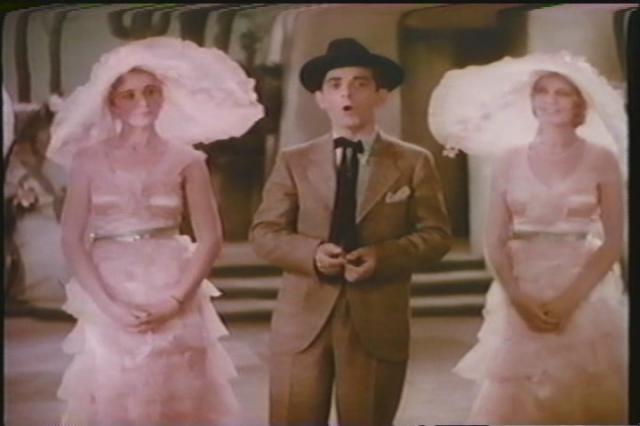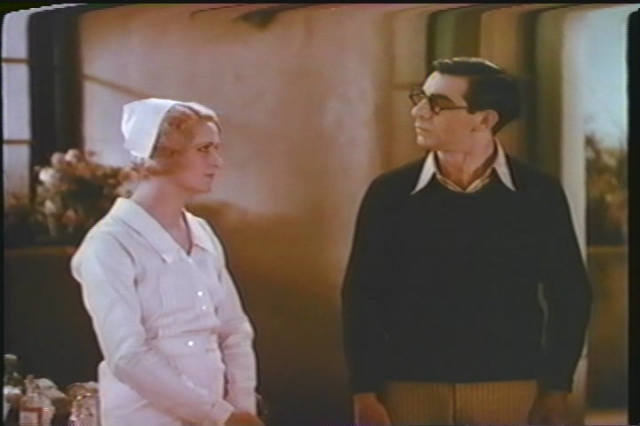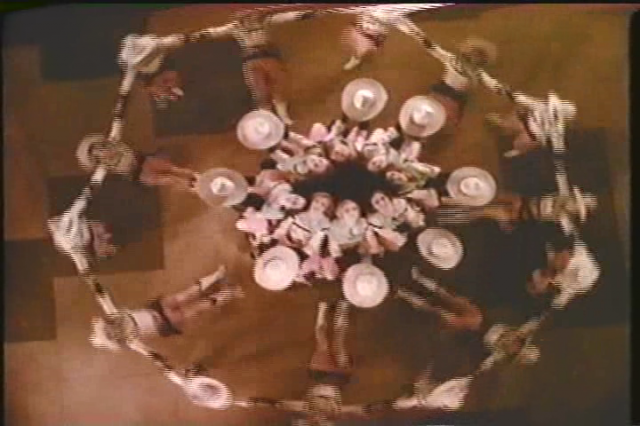|
Genres, Themes, Actors, and Directors:
- Busby Berkeley Films
- Comedy
- Cross-Cultural Romance
- Eddie Cantor Films
- Musicals
- Native Americans
- Play Adaptation
Review:
Adapted from Flo Ziegfield’s popular Broadway musical (itself based on Owen Davis’s comedic play The Nervous Wreck), Whoopee! was the film that jump-started Eddie Cantor’s cinematic career, and remains a compelling showcase of his nebbishy, eye-rolling wit. The story — romantic fluff at its tritest — is really just an excuse for Ziegfield’s “girls” to strut their stuff (courtesy of Busby Berkeley’s iconic choreography) and for Cantor to sling one-liners left and right; when he drolly intones “Last week I looked so terrible, two undertakers left a deposit on me”, his influence on Woody Allen couldn’t be more distinct. Unfortunately, we’re forced to suffer through Cantor in characteristic blackface for a good section of the film, with the worst moment occurring when the cluelessly soot-covered Cantor greets Hunt, who responds with a hostile “How dare you speak to me!”.
Barring this — and the use of cliched jokes about Native Americans — the remainder of the film is essentially an innocuous tale of mistaken identities and unrequited love, with Ethel Shutta particularly appealing as Cantor’s feisty love interest; she more than holds her own in concert with him. Also notable are Gus Kahn’s lyrics, which are quite fun (note in particular the clever stanzas in “A Girl Friend of a Boy Friend of Mine”). Strangely enough, Cantor’s rendition of the famed title song (“Making Whoopee”) is lackluster and too-slow; he’s much livelier when singing a spoof later on, “Making Waffles” (pronounced, curiously enough, like “Making Raffles”).
Note: Famed cinematographers Lee Garmes and Gregg Toland both served as DPs on the project, but what’s most noticeable about the film’s “look” is the effective use of two-tone Technicolor.
Redeeming Qualities and Moments:
- Plenty of zingy one-liners by Cantor

- Ethel Shutta as Cantor’s romantically inclined nurse

- Some fun Busby Berkeley productions

Must See?
Yes, simply as a representative (and reasonably enjoyable) Eddie Cantor film.
Categories
Links:
|
One thought on “Whoopee (1930)”
First viewing. Not must-see – but it is notable for Berkeley’s choreography (which shows how many choreographers of his day just weren’t all that creative), director Thornton Freeland’s fine handling of underwhelming comic material…and esp. a rare opportunity to see the talented Ethel Shutta (interestingly, pronounced ‘Shoo-TAY’).
As you make your way through Peary’s lists of titles, you become very aware that he has a particular interest in including many, many titles which string together an evolution of comedy in film. Many of these titles are, in fact, either uninteresting (many are downright dull) or (in the case of ‘Whoopee’ and others) sadly dated. All of these titles are, in fact, of little real interest to dedicated film fanatics – but they are, of course, probably to be checked out by those who have a real curiosity about how film comedy changed (and gradually became much more sophisticated and intelligent) as decades changed.
A little research on this one shows that Ruth Etting appeared in the Broadway version, from which she gained her signature song ‘Love Me or Leave Me’. Both Etting and the song are missing from the film.
The title of the film is much more interesting when we keep in mind that ‘Whoopee’ is a euphemism (as per the film’s title song) for ‘Sex’ or ‘Having Sex’. Wouldn’t it have been a riot if, in 1930, the marquee had read…Eddie Cantor in ‘Fucking’. 😉
Since I wasn’t really enjoying the film, I focused on how director Freeland was handling the whole thing. It’s largely to his credit that he took the material seriously – by that I mean, he took pains to make it look good, move people around well, and pay attention to comic potential visually.
I did get a chuckle out of one routine: in which Cantor and Spencer Charters are engaged in a ‘Who has had a worse life?’ routine (a routine which – for a long time, though always written differently, was a staple sequence for various comic writers/performers). In this one, an increasingly energetic and physical comparison of operation scars becomes (esp. now) more than mildly homoerotic (though it would perhaps not seem so in 1930, who knows?).
I did esp. enjoy watching Shutta, esp. in the standout number ‘Stetson’ which she shares with a bunch of cowboys. She’s quite something to watch. She’s also a nice foil for Cantor; fortunately, unlike him, she is not saddled with a bunch of corny jokes to deliver. I don’t think I’ve seen her elsewhere (yet) in film. But I did see her at age 73, when she returned to Broadway in Sondheim’s ‘Follies’ – to memorably sing ‘Broadway Baby’. She was a knockout.